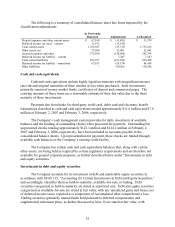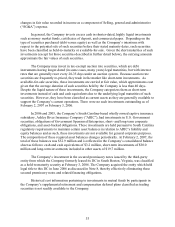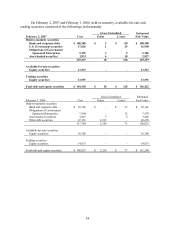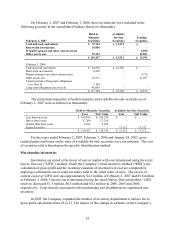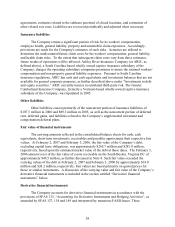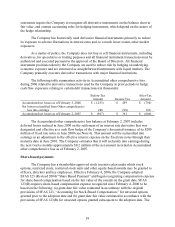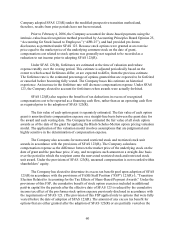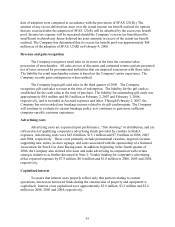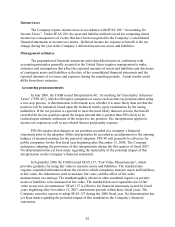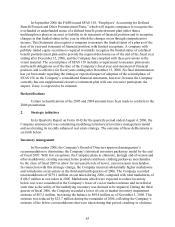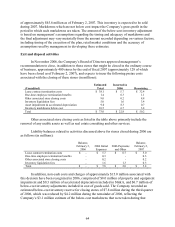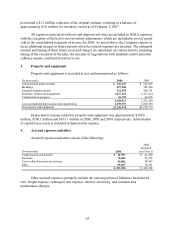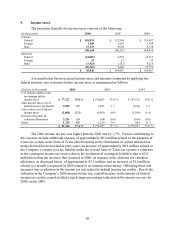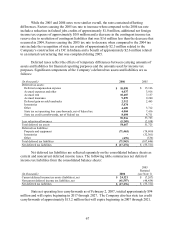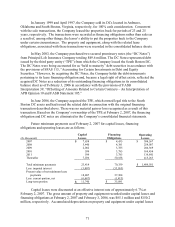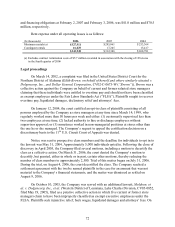Dollar General 2006 Annual Report Download - page 64
Download and view the complete annual report
Please find page 64 of the 2006 Dollar General annual report below. You can navigate through the pages in the report by either clicking on the pages listed below, or by using the keyword search tool below to find specific information within the annual report.Income taxes
The Company reports income taxes in accordance with SFAS 109, “Accounting for
Income Taxes”. Under SFAS 109, the asset and liability method is used for computing future
income tax consequences of events that have been recognized in the Company’ s consolidated
financial statements or income tax returns. Deferred income tax expense or benefit is the net
change during the year in the Company’ s deferred income tax assets and liabilities.
Management estimates
The preparation of financial statements and related disclosures in conformity with
accounting principles generally accepted in the United States requires management to make
estimates and assumptions that affect the reported amounts of assets and liabilities and disclosure
of contingent assets and liabilities at the date of the consolidated financial statements and the
reported amounts of revenues and expenses during the reporting periods. Actual results could
differ from those estimates.
Accounting pronouncements
In July 2006, the FASB issued Interpretation 48, “Accounting for Uncertainty in Income
Taxes” (“FIN 48”), which will require companies to assess each income tax position taken using
a two-step process. A determination is first made as to whether it is more likely than not that the
position will be sustained, based upon the technical merits, upon examination by the taxing
authorities. If the tax position is expected to meet the more likely than not criteria, the benefit
recorded for the tax position equals the largest amount that is greater than 50% likely to be
realized upon ultimate settlement of the respective tax position. The interpretation applies to
income tax expense as well as any related interest and penalty expense.
FIN 48 requires that changes in tax positions recorded in a company’ s financial
statements prior to the adoption of this interpretation be recorded as an adjustment to the opening
balance of retained earnings for the period of adoption. FIN 48 will generally be effective for
public companies for the first fiscal year beginning after December 15, 2006. The Company
anticipates adopting the provisions of this interpretation during the first quarter of fiscal 2007.
No determination has yet been made regarding the materiality of the potential impact of this
interpretation on the Company’s financial statements.
In September 2006 the FASB issued SFAS 157, “Fair Value Measurements”, which
provides guidance for using fair value to measure assets and liabilities. The standard also
requires expanded information about the extent to which companies measure assets and liabilities
at fair value, the information used to measure fair value, and the effect of fair value
measurements on earnings. The standard applies whenever other standards require (or permit)
assets or liabilities to be measured at fair value. The standard does not expand the use of fair
value in any new circumstances. SFAS 157 is effective for financial statements issued for fiscal
years beginning after November 15, 2007, and interim periods within those fiscal years. The
Company currently expects to adopt SFAS 157 during the 2008 fiscal year. No determination has
yet been made regarding the potential impact of this standard on the Company’ s financial
statements.
62


